Social Media: Trends, Benefits, Drawbacks, and Ethical Considerations
VerifiedAdded on 2020/04/07
|10
|2696
|115
Report
AI Summary
This report provides a comprehensive analysis of social media, exploring its trends, benefits, and drawbacks. It delves into the ethical considerations surrounding social media research, including concerns about privacy, informed consent, and the potential for cyberbullying and identity theft. The report examines the impact of social media on both businesses and individuals, highlighting how businesses use social media for advertising and customer service, while also acknowledging the risks associated with corporate privacy and the spread of misinformation. Furthermore, the report discusses the evolving trends in social media, such as the use of filters and short video stories. The research emphasizes the need for responsible social media usage and highlights the importance of understanding the multifaceted effects of social media in the contemporary digital landscape.
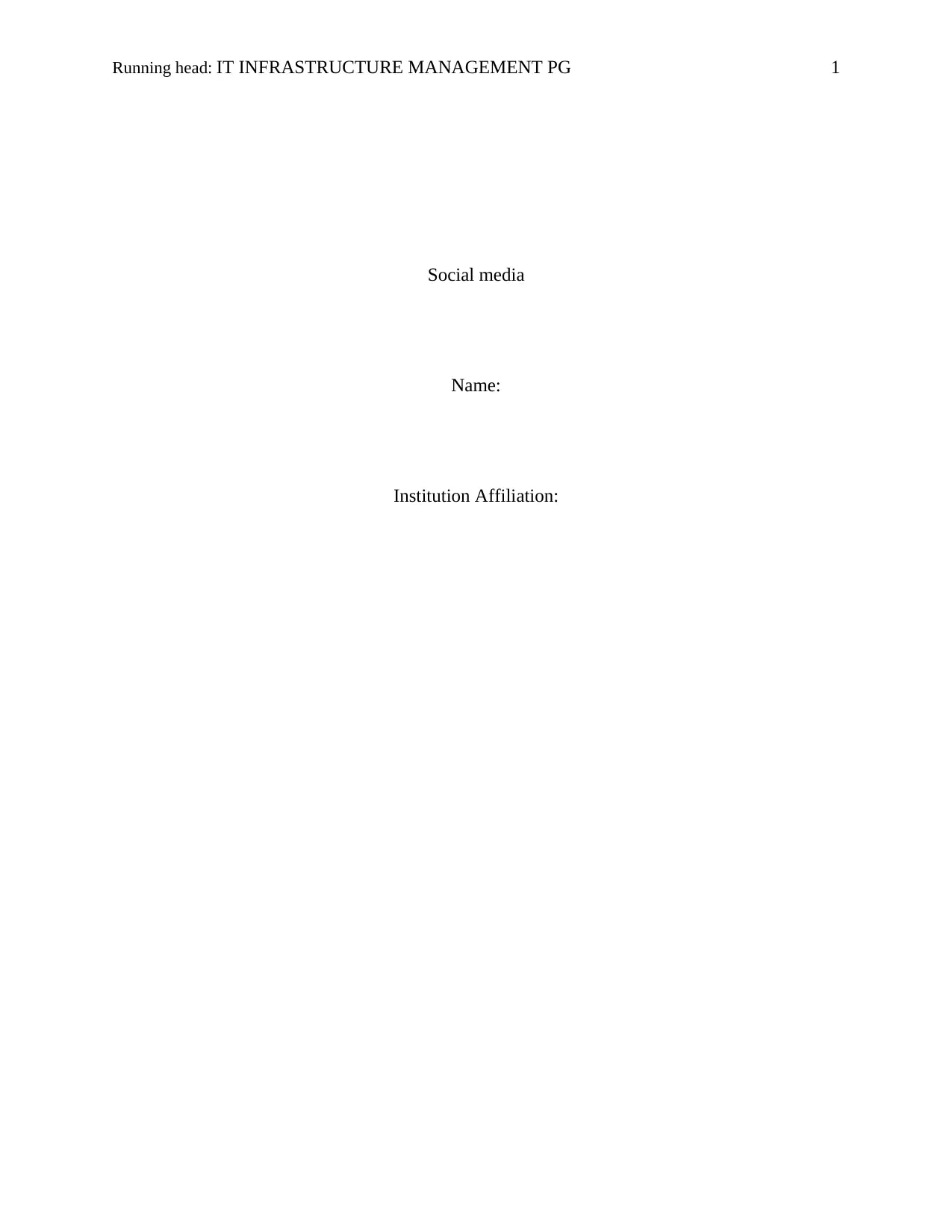
Running head: IT INFRASTRUCTURE MANAGEMENT PG 1
Social media
Name:
Institution Affiliation:
Social media
Name:
Institution Affiliation:
Paraphrase This Document
Need a fresh take? Get an instant paraphrase of this document with our AI Paraphraser
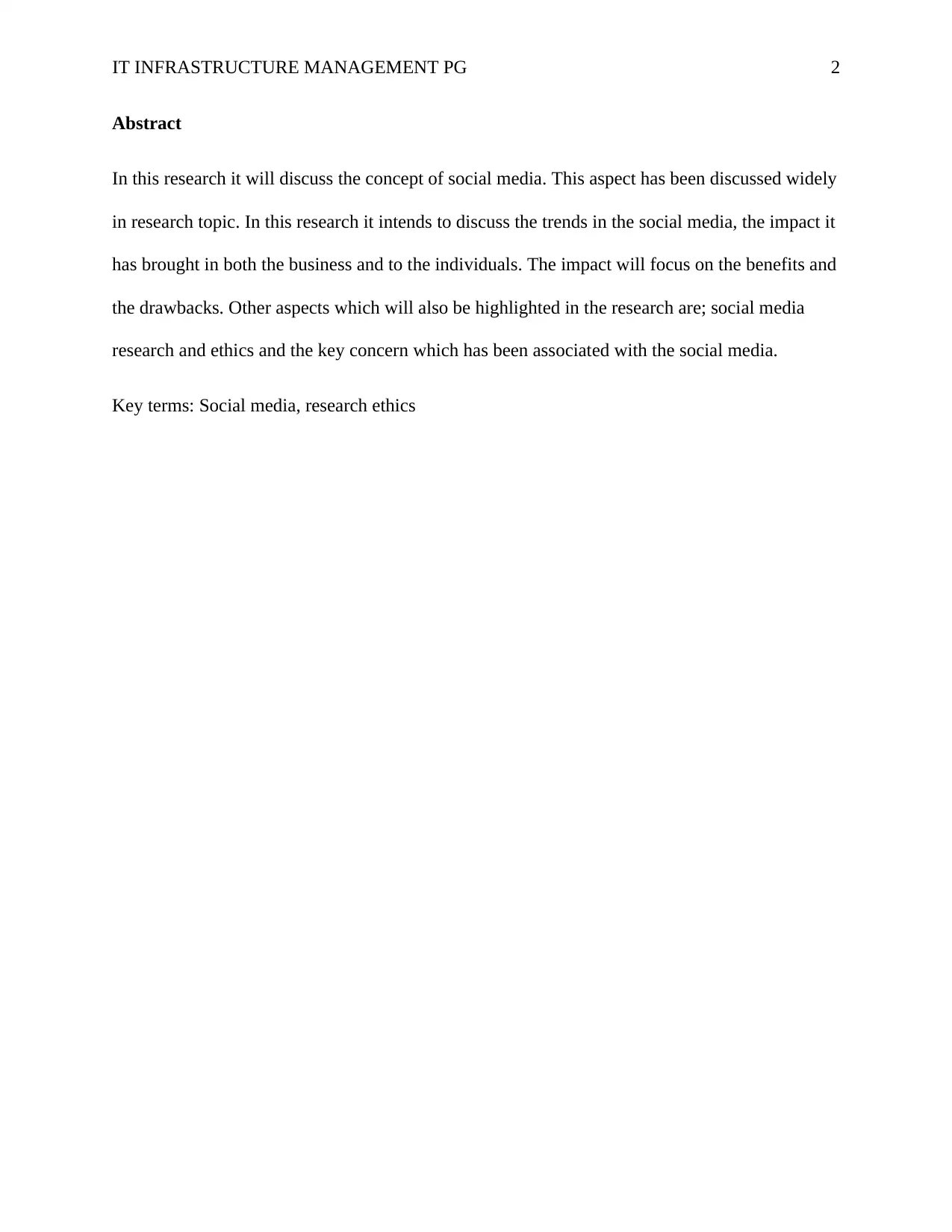
IT INFRASTRUCTURE MANAGEMENT PG 2
Abstract
In this research it will discuss the concept of social media. This aspect has been discussed widely
in research topic. In this research it intends to discuss the trends in the social media, the impact it
has brought in both the business and to the individuals. The impact will focus on the benefits and
the drawbacks. Other aspects which will also be highlighted in the research are; social media
research and ethics and the key concern which has been associated with the social media.
Key terms: Social media, research ethics
Abstract
In this research it will discuss the concept of social media. This aspect has been discussed widely
in research topic. In this research it intends to discuss the trends in the social media, the impact it
has brought in both the business and to the individuals. The impact will focus on the benefits and
the drawbacks. Other aspects which will also be highlighted in the research are; social media
research and ethics and the key concern which has been associated with the social media.
Key terms: Social media, research ethics
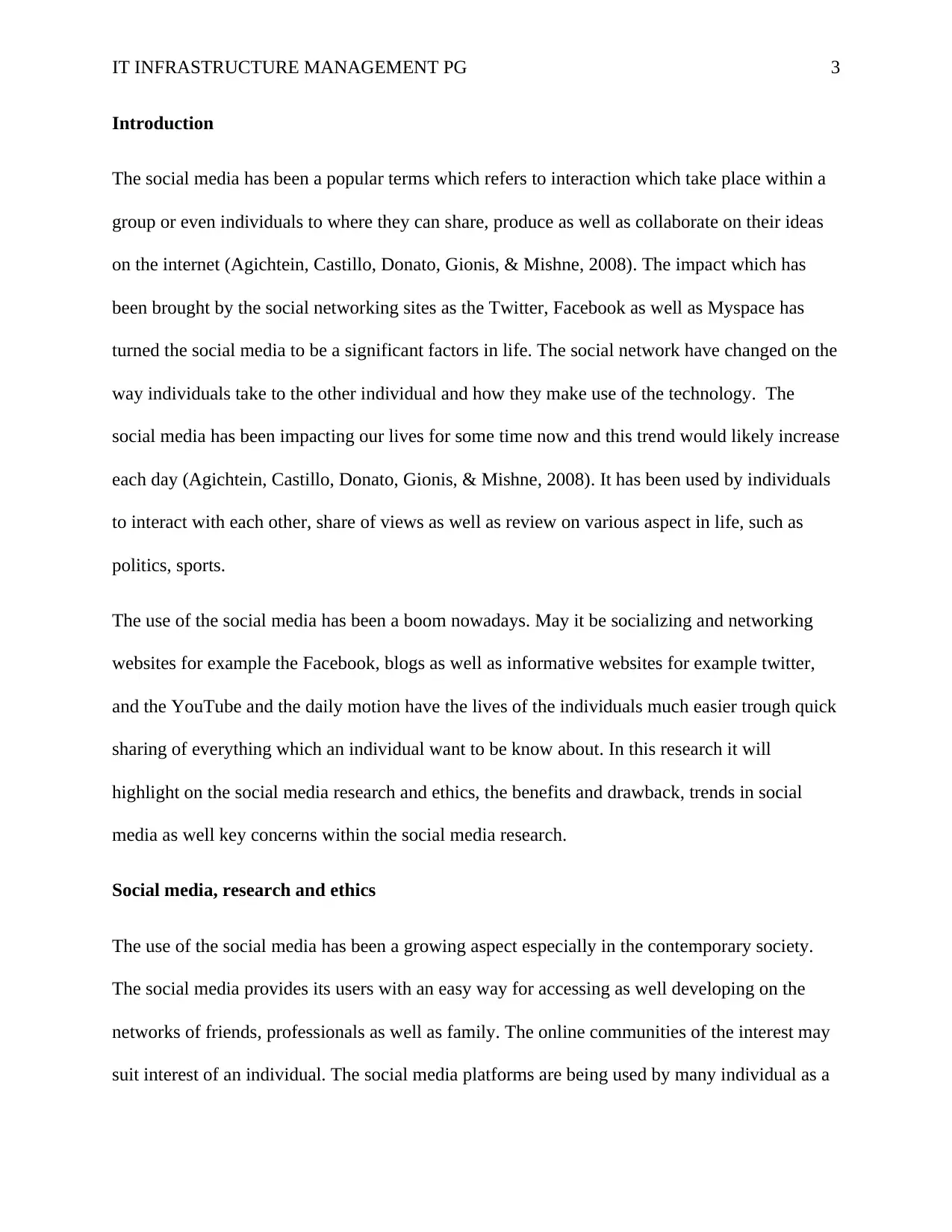
IT INFRASTRUCTURE MANAGEMENT PG 3
Introduction
The social media has been a popular terms which refers to interaction which take place within a
group or even individuals to where they can share, produce as well as collaborate on their ideas
on the internet (Agichtein, Castillo, Donato, Gionis, & Mishne, 2008). The impact which has
been brought by the social networking sites as the Twitter, Facebook as well as Myspace has
turned the social media to be a significant factors in life. The social network have changed on the
way individuals take to the other individual and how they make use of the technology. The
social media has been impacting our lives for some time now and this trend would likely increase
each day (Agichtein, Castillo, Donato, Gionis, & Mishne, 2008). It has been used by individuals
to interact with each other, share of views as well as review on various aspect in life, such as
politics, sports.
The use of the social media has been a boom nowadays. May it be socializing and networking
websites for example the Facebook, blogs as well as informative websites for example twitter,
and the YouTube and the daily motion have the lives of the individuals much easier trough quick
sharing of everything which an individual want to be know about. In this research it will
highlight on the social media research and ethics, the benefits and drawback, trends in social
media as well key concerns within the social media research.
Social media, research and ethics
The use of the social media has been a growing aspect especially in the contemporary society.
The social media provides its users with an easy way for accessing as well developing on the
networks of friends, professionals as well as family. The online communities of the interest may
suit interest of an individual. The social media platforms are being used by many individual as a
Introduction
The social media has been a popular terms which refers to interaction which take place within a
group or even individuals to where they can share, produce as well as collaborate on their ideas
on the internet (Agichtein, Castillo, Donato, Gionis, & Mishne, 2008). The impact which has
been brought by the social networking sites as the Twitter, Facebook as well as Myspace has
turned the social media to be a significant factors in life. The social network have changed on the
way individuals take to the other individual and how they make use of the technology. The
social media has been impacting our lives for some time now and this trend would likely increase
each day (Agichtein, Castillo, Donato, Gionis, & Mishne, 2008). It has been used by individuals
to interact with each other, share of views as well as review on various aspect in life, such as
politics, sports.
The use of the social media has been a boom nowadays. May it be socializing and networking
websites for example the Facebook, blogs as well as informative websites for example twitter,
and the YouTube and the daily motion have the lives of the individuals much easier trough quick
sharing of everything which an individual want to be know about. In this research it will
highlight on the social media research and ethics, the benefits and drawback, trends in social
media as well key concerns within the social media research.
Social media, research and ethics
The use of the social media has been a growing aspect especially in the contemporary society.
The social media provides its users with an easy way for accessing as well developing on the
networks of friends, professionals as well as family. The online communities of the interest may
suit interest of an individual. The social media platforms are being used by many individual as a
⊘ This is a preview!⊘
Do you want full access?
Subscribe today to unlock all pages.

Trusted by 1+ million students worldwide
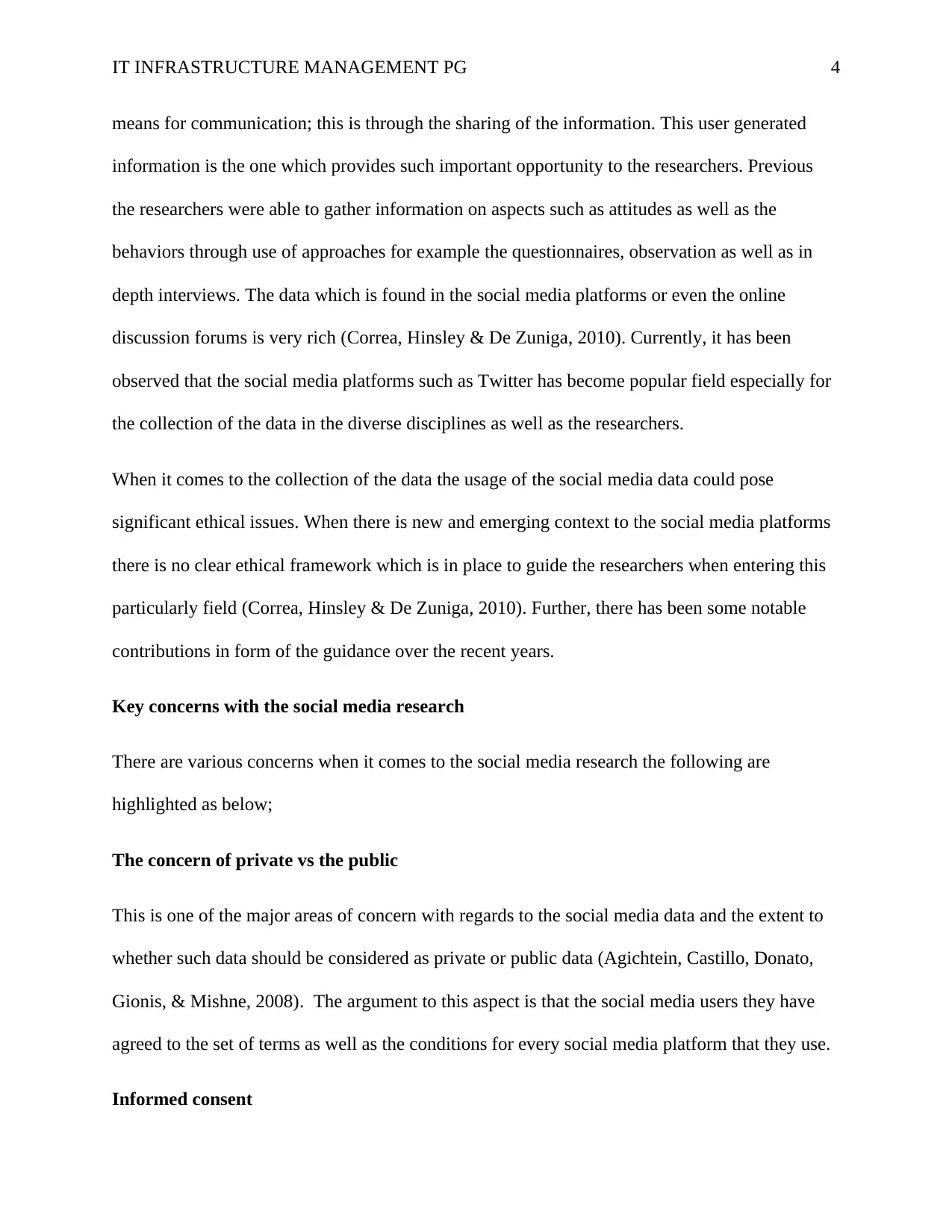
IT INFRASTRUCTURE MANAGEMENT PG 4
means for communication; this is through the sharing of the information. This user generated
information is the one which provides such important opportunity to the researchers. Previous
the researchers were able to gather information on aspects such as attitudes as well as the
behaviors through use of approaches for example the questionnaires, observation as well as in
depth interviews. The data which is found in the social media platforms or even the online
discussion forums is very rich (Correa, Hinsley & De Zuniga, 2010). Currently, it has been
observed that the social media platforms such as Twitter has become popular field especially for
the collection of the data in the diverse disciplines as well as the researchers.
When it comes to the collection of the data the usage of the social media data could pose
significant ethical issues. When there is new and emerging context to the social media platforms
there is no clear ethical framework which is in place to guide the researchers when entering this
particularly field (Correa, Hinsley & De Zuniga, 2010). Further, there has been some notable
contributions in form of the guidance over the recent years.
Key concerns with the social media research
There are various concerns when it comes to the social media research the following are
highlighted as below;
The concern of private vs the public
This is one of the major areas of concern with regards to the social media data and the extent to
whether such data should be considered as private or public data (Agichtein, Castillo, Donato,
Gionis, & Mishne, 2008). The argument to this aspect is that the social media users they have
agreed to the set of terms as well as the conditions for every social media platform that they use.
Informed consent
means for communication; this is through the sharing of the information. This user generated
information is the one which provides such important opportunity to the researchers. Previous
the researchers were able to gather information on aspects such as attitudes as well as the
behaviors through use of approaches for example the questionnaires, observation as well as in
depth interviews. The data which is found in the social media platforms or even the online
discussion forums is very rich (Correa, Hinsley & De Zuniga, 2010). Currently, it has been
observed that the social media platforms such as Twitter has become popular field especially for
the collection of the data in the diverse disciplines as well as the researchers.
When it comes to the collection of the data the usage of the social media data could pose
significant ethical issues. When there is new and emerging context to the social media platforms
there is no clear ethical framework which is in place to guide the researchers when entering this
particularly field (Correa, Hinsley & De Zuniga, 2010). Further, there has been some notable
contributions in form of the guidance over the recent years.
Key concerns with the social media research
There are various concerns when it comes to the social media research the following are
highlighted as below;
The concern of private vs the public
This is one of the major areas of concern with regards to the social media data and the extent to
whether such data should be considered as private or public data (Agichtein, Castillo, Donato,
Gionis, & Mishne, 2008). The argument to this aspect is that the social media users they have
agreed to the set of terms as well as the conditions for every social media platform that they use.
Informed consent
Paraphrase This Document
Need a fresh take? Get an instant paraphrase of this document with our AI Paraphraser
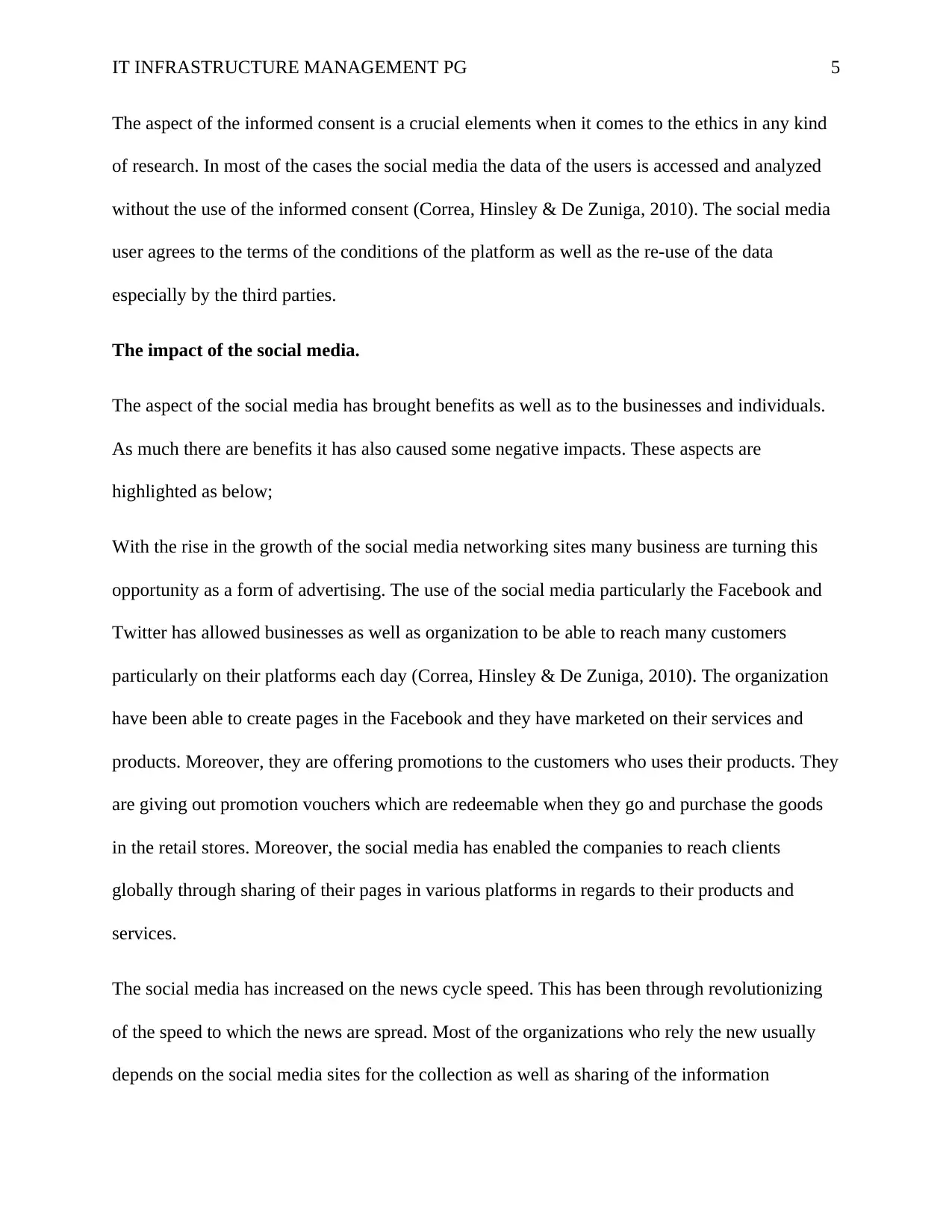
IT INFRASTRUCTURE MANAGEMENT PG 5
The aspect of the informed consent is a crucial elements when it comes to the ethics in any kind
of research. In most of the cases the social media the data of the users is accessed and analyzed
without the use of the informed consent (Correa, Hinsley & De Zuniga, 2010). The social media
user agrees to the terms of the conditions of the platform as well as the re-use of the data
especially by the third parties.
The impact of the social media.
The aspect of the social media has brought benefits as well as to the businesses and individuals.
As much there are benefits it has also caused some negative impacts. These aspects are
highlighted as below;
With the rise in the growth of the social media networking sites many business are turning this
opportunity as a form of advertising. The use of the social media particularly the Facebook and
Twitter has allowed businesses as well as organization to be able to reach many customers
particularly on their platforms each day (Correa, Hinsley & De Zuniga, 2010). The organization
have been able to create pages in the Facebook and they have marketed on their services and
products. Moreover, they are offering promotions to the customers who uses their products. They
are giving out promotion vouchers which are redeemable when they go and purchase the goods
in the retail stores. Moreover, the social media has enabled the companies to reach clients
globally through sharing of their pages in various platforms in regards to their products and
services.
The social media has increased on the news cycle speed. This has been through revolutionizing
of the speed to which the news are spread. Most of the organizations who rely the new usually
depends on the social media sites for the collection as well as sharing of the information
The aspect of the informed consent is a crucial elements when it comes to the ethics in any kind
of research. In most of the cases the social media the data of the users is accessed and analyzed
without the use of the informed consent (Correa, Hinsley & De Zuniga, 2010). The social media
user agrees to the terms of the conditions of the platform as well as the re-use of the data
especially by the third parties.
The impact of the social media.
The aspect of the social media has brought benefits as well as to the businesses and individuals.
As much there are benefits it has also caused some negative impacts. These aspects are
highlighted as below;
With the rise in the growth of the social media networking sites many business are turning this
opportunity as a form of advertising. The use of the social media particularly the Facebook and
Twitter has allowed businesses as well as organization to be able to reach many customers
particularly on their platforms each day (Correa, Hinsley & De Zuniga, 2010). The organization
have been able to create pages in the Facebook and they have marketed on their services and
products. Moreover, they are offering promotions to the customers who uses their products. They
are giving out promotion vouchers which are redeemable when they go and purchase the goods
in the retail stores. Moreover, the social media has enabled the companies to reach clients
globally through sharing of their pages in various platforms in regards to their products and
services.
The social media has increased on the news cycle speed. This has been through revolutionizing
of the speed to which the news are spread. Most of the organizations who rely the new usually
depends on the social media sites for the collection as well as sharing of the information
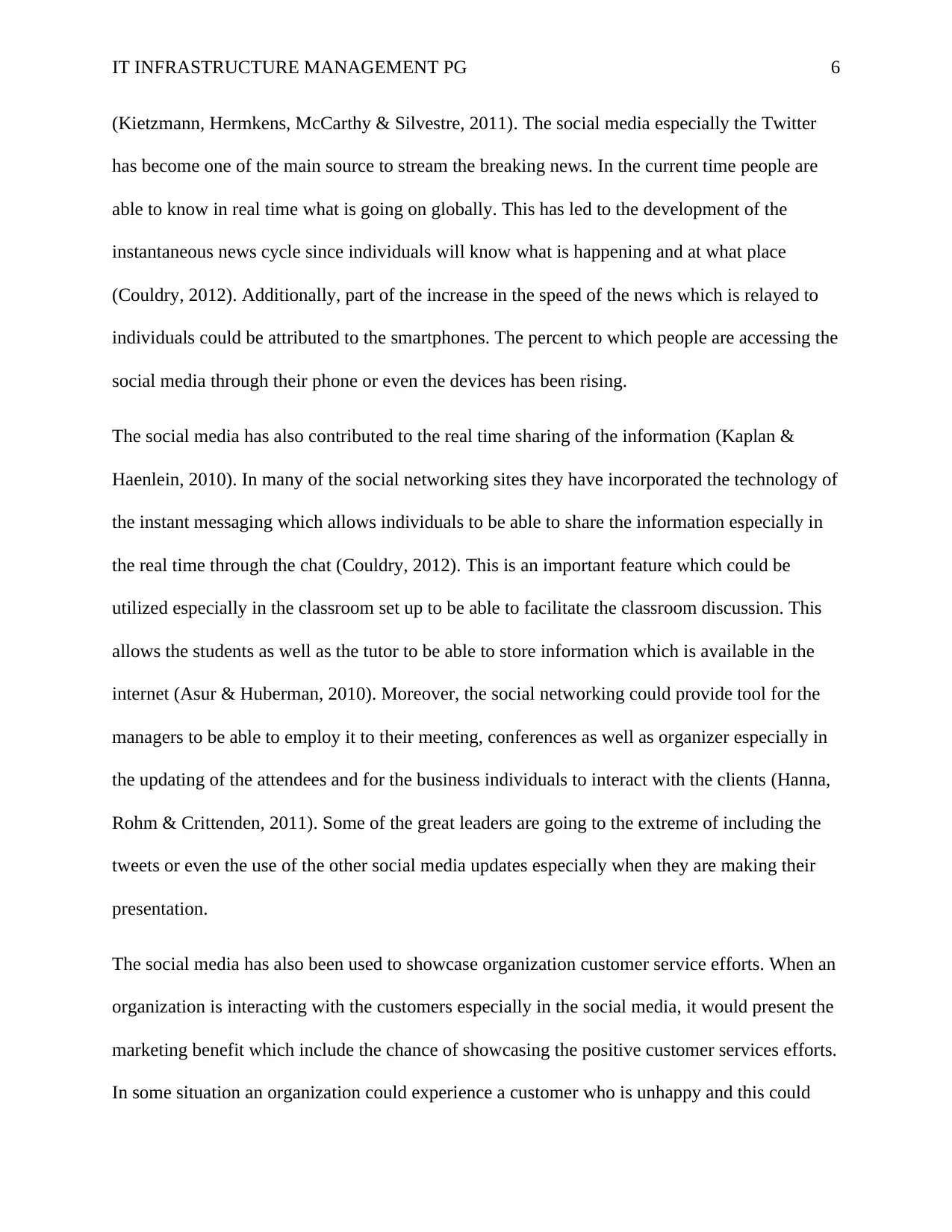
IT INFRASTRUCTURE MANAGEMENT PG 6
(Kietzmann, Hermkens, McCarthy & Silvestre, 2011). The social media especially the Twitter
has become one of the main source to stream the breaking news. In the current time people are
able to know in real time what is going on globally. This has led to the development of the
instantaneous news cycle since individuals will know what is happening and at what place
(Couldry, 2012). Additionally, part of the increase in the speed of the news which is relayed to
individuals could be attributed to the smartphones. The percent to which people are accessing the
social media through their phone or even the devices has been rising.
The social media has also contributed to the real time sharing of the information (Kaplan &
Haenlein, 2010). In many of the social networking sites they have incorporated the technology of
the instant messaging which allows individuals to be able to share the information especially in
the real time through the chat (Couldry, 2012). This is an important feature which could be
utilized especially in the classroom set up to be able to facilitate the classroom discussion. This
allows the students as well as the tutor to be able to store information which is available in the
internet (Asur & Huberman, 2010). Moreover, the social networking could provide tool for the
managers to be able to employ it to their meeting, conferences as well as organizer especially in
the updating of the attendees and for the business individuals to interact with the clients (Hanna,
Rohm & Crittenden, 2011). Some of the great leaders are going to the extreme of including the
tweets or even the use of the other social media updates especially when they are making their
presentation.
The social media has also been used to showcase organization customer service efforts. When an
organization is interacting with the customers especially in the social media, it would present the
marketing benefit which include the chance of showcasing the positive customer services efforts.
In some situation an organization could experience a customer who is unhappy and this could
(Kietzmann, Hermkens, McCarthy & Silvestre, 2011). The social media especially the Twitter
has become one of the main source to stream the breaking news. In the current time people are
able to know in real time what is going on globally. This has led to the development of the
instantaneous news cycle since individuals will know what is happening and at what place
(Couldry, 2012). Additionally, part of the increase in the speed of the news which is relayed to
individuals could be attributed to the smartphones. The percent to which people are accessing the
social media through their phone or even the devices has been rising.
The social media has also contributed to the real time sharing of the information (Kaplan &
Haenlein, 2010). In many of the social networking sites they have incorporated the technology of
the instant messaging which allows individuals to be able to share the information especially in
the real time through the chat (Couldry, 2012). This is an important feature which could be
utilized especially in the classroom set up to be able to facilitate the classroom discussion. This
allows the students as well as the tutor to be able to store information which is available in the
internet (Asur & Huberman, 2010). Moreover, the social networking could provide tool for the
managers to be able to employ it to their meeting, conferences as well as organizer especially in
the updating of the attendees and for the business individuals to interact with the clients (Hanna,
Rohm & Crittenden, 2011). Some of the great leaders are going to the extreme of including the
tweets or even the use of the other social media updates especially when they are making their
presentation.
The social media has also been used to showcase organization customer service efforts. When an
organization is interacting with the customers especially in the social media, it would present the
marketing benefit which include the chance of showcasing the positive customer services efforts.
In some situation an organization could experience a customer who is unhappy and this could
⊘ This is a preview!⊘
Do you want full access?
Subscribe today to unlock all pages.

Trusted by 1+ million students worldwide
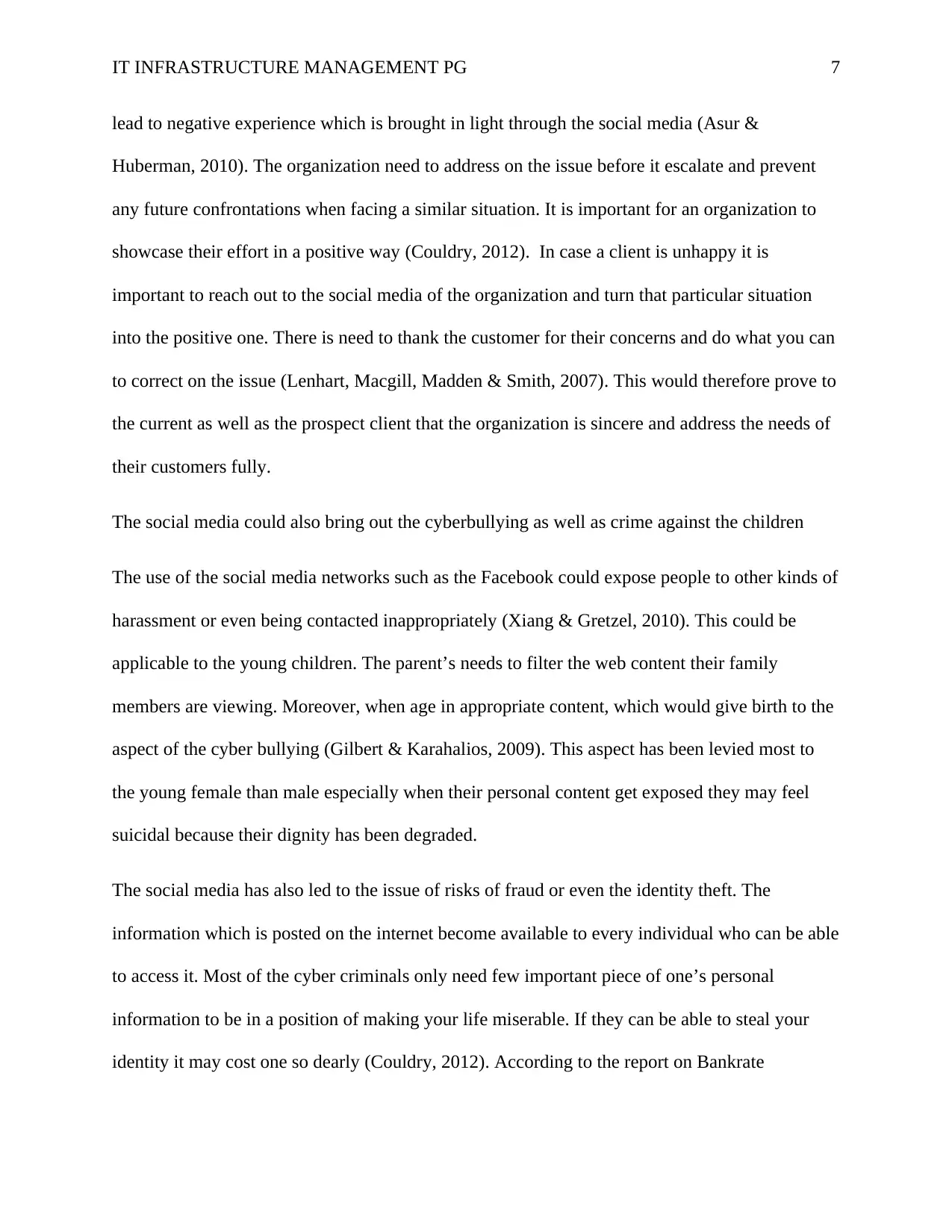
IT INFRASTRUCTURE MANAGEMENT PG 7
lead to negative experience which is brought in light through the social media (Asur &
Huberman, 2010). The organization need to address on the issue before it escalate and prevent
any future confrontations when facing a similar situation. It is important for an organization to
showcase their effort in a positive way (Couldry, 2012). In case a client is unhappy it is
important to reach out to the social media of the organization and turn that particular situation
into the positive one. There is need to thank the customer for their concerns and do what you can
to correct on the issue (Lenhart, Macgill, Madden & Smith, 2007). This would therefore prove to
the current as well as the prospect client that the organization is sincere and address the needs of
their customers fully.
The social media could also bring out the cyberbullying as well as crime against the children
The use of the social media networks such as the Facebook could expose people to other kinds of
harassment or even being contacted inappropriately (Xiang & Gretzel, 2010). This could be
applicable to the young children. The parent’s needs to filter the web content their family
members are viewing. Moreover, when age in appropriate content, which would give birth to the
aspect of the cyber bullying (Gilbert & Karahalios, 2009). This aspect has been levied most to
the young female than male especially when their personal content get exposed they may feel
suicidal because their dignity has been degraded.
The social media has also led to the issue of risks of fraud or even the identity theft. The
information which is posted on the internet become available to every individual who can be able
to access it. Most of the cyber criminals only need few important piece of one’s personal
information to be in a position of making your life miserable. If they can be able to steal your
identity it may cost one so dearly (Couldry, 2012). According to the report on Bankrate
lead to negative experience which is brought in light through the social media (Asur &
Huberman, 2010). The organization need to address on the issue before it escalate and prevent
any future confrontations when facing a similar situation. It is important for an organization to
showcase their effort in a positive way (Couldry, 2012). In case a client is unhappy it is
important to reach out to the social media of the organization and turn that particular situation
into the positive one. There is need to thank the customer for their concerns and do what you can
to correct on the issue (Lenhart, Macgill, Madden & Smith, 2007). This would therefore prove to
the current as well as the prospect client that the organization is sincere and address the needs of
their customers fully.
The social media could also bring out the cyberbullying as well as crime against the children
The use of the social media networks such as the Facebook could expose people to other kinds of
harassment or even being contacted inappropriately (Xiang & Gretzel, 2010). This could be
applicable to the young children. The parent’s needs to filter the web content their family
members are viewing. Moreover, when age in appropriate content, which would give birth to the
aspect of the cyber bullying (Gilbert & Karahalios, 2009). This aspect has been levied most to
the young female than male especially when their personal content get exposed they may feel
suicidal because their dignity has been degraded.
The social media has also led to the issue of risks of fraud or even the identity theft. The
information which is posted on the internet become available to every individual who can be able
to access it. Most of the cyber criminals only need few important piece of one’s personal
information to be in a position of making your life miserable. If they can be able to steal your
identity it may cost one so dearly (Couldry, 2012). According to the report on Bankrate
Paraphrase This Document
Need a fresh take? Get an instant paraphrase of this document with our AI Paraphraser
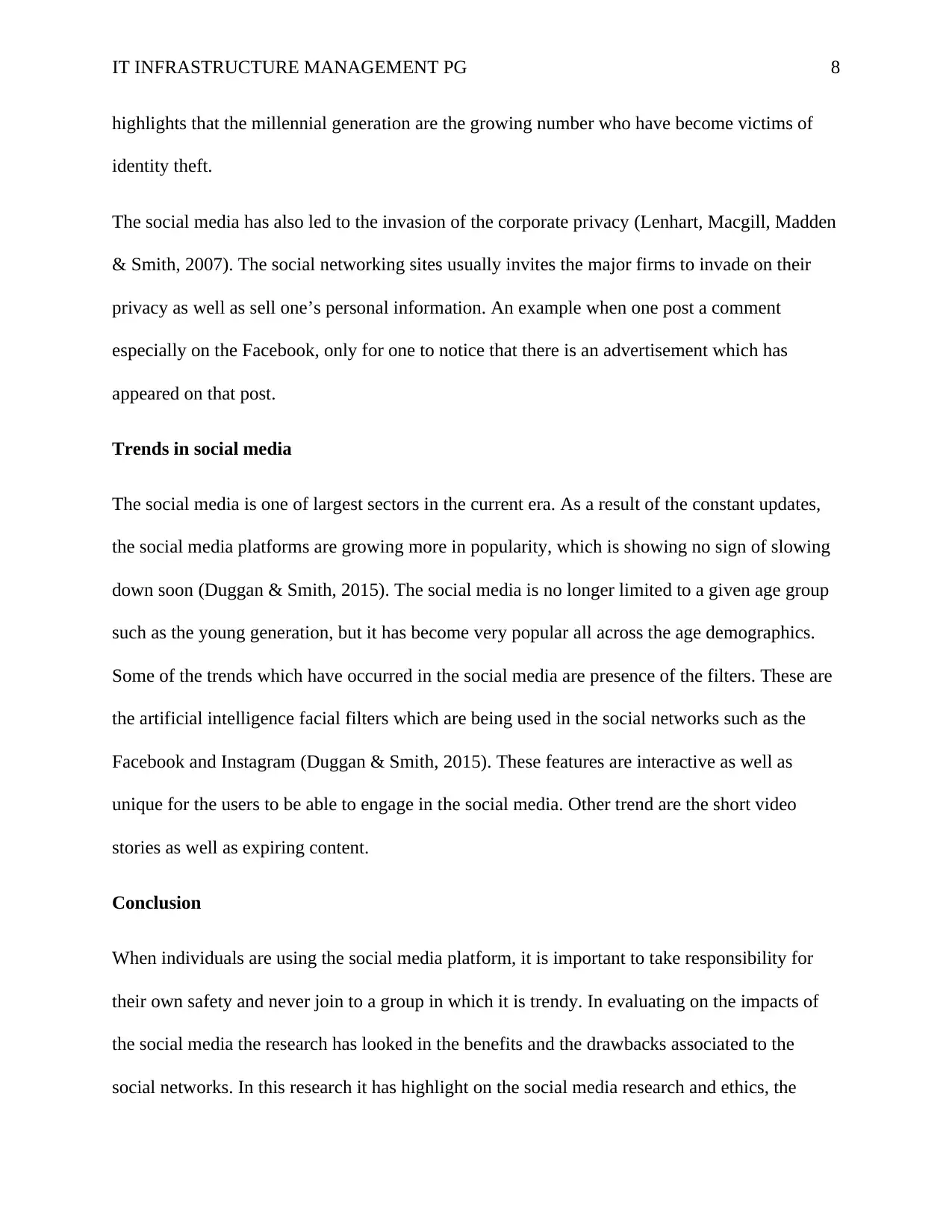
IT INFRASTRUCTURE MANAGEMENT PG 8
highlights that the millennial generation are the growing number who have become victims of
identity theft.
The social media has also led to the invasion of the corporate privacy (Lenhart, Macgill, Madden
& Smith, 2007). The social networking sites usually invites the major firms to invade on their
privacy as well as sell one’s personal information. An example when one post a comment
especially on the Facebook, only for one to notice that there is an advertisement which has
appeared on that post.
Trends in social media
The social media is one of largest sectors in the current era. As a result of the constant updates,
the social media platforms are growing more in popularity, which is showing no sign of slowing
down soon (Duggan & Smith, 2015). The social media is no longer limited to a given age group
such as the young generation, but it has become very popular all across the age demographics.
Some of the trends which have occurred in the social media are presence of the filters. These are
the artificial intelligence facial filters which are being used in the social networks such as the
Facebook and Instagram (Duggan & Smith, 2015). These features are interactive as well as
unique for the users to be able to engage in the social media. Other trend are the short video
stories as well as expiring content.
Conclusion
When individuals are using the social media platform, it is important to take responsibility for
their own safety and never join to a group in which it is trendy. In evaluating on the impacts of
the social media the research has looked in the benefits and the drawbacks associated to the
social networks. In this research it has highlight on the social media research and ethics, the
highlights that the millennial generation are the growing number who have become victims of
identity theft.
The social media has also led to the invasion of the corporate privacy (Lenhart, Macgill, Madden
& Smith, 2007). The social networking sites usually invites the major firms to invade on their
privacy as well as sell one’s personal information. An example when one post a comment
especially on the Facebook, only for one to notice that there is an advertisement which has
appeared on that post.
Trends in social media
The social media is one of largest sectors in the current era. As a result of the constant updates,
the social media platforms are growing more in popularity, which is showing no sign of slowing
down soon (Duggan & Smith, 2015). The social media is no longer limited to a given age group
such as the young generation, but it has become very popular all across the age demographics.
Some of the trends which have occurred in the social media are presence of the filters. These are
the artificial intelligence facial filters which are being used in the social networks such as the
Facebook and Instagram (Duggan & Smith, 2015). These features are interactive as well as
unique for the users to be able to engage in the social media. Other trend are the short video
stories as well as expiring content.
Conclusion
When individuals are using the social media platform, it is important to take responsibility for
their own safety and never join to a group in which it is trendy. In evaluating on the impacts of
the social media the research has looked in the benefits and the drawbacks associated to the
social networks. In this research it has highlight on the social media research and ethics, the

IT INFRASTRUCTURE MANAGEMENT PG 9
benefits and drawback, trends in social media as well key concerns within the social media
research.
benefits and drawback, trends in social media as well key concerns within the social media
research.
⊘ This is a preview!⊘
Do you want full access?
Subscribe today to unlock all pages.

Trusted by 1+ million students worldwide
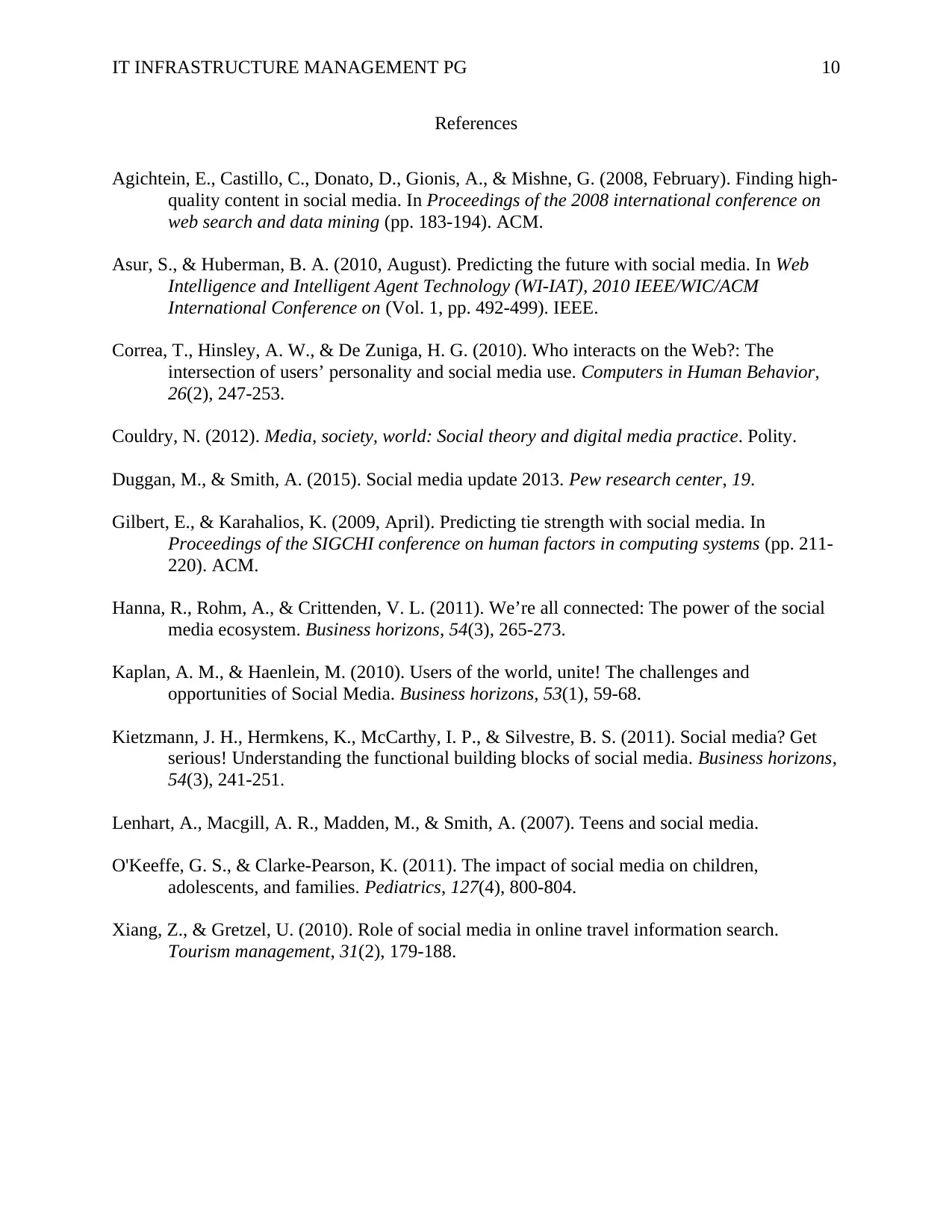
IT INFRASTRUCTURE MANAGEMENT PG 10
References
Agichtein, E., Castillo, C., Donato, D., Gionis, A., & Mishne, G. (2008, February). Finding high-
quality content in social media. In Proceedings of the 2008 international conference on
web search and data mining (pp. 183-194). ACM.
Asur, S., & Huberman, B. A. (2010, August). Predicting the future with social media. In Web
Intelligence and Intelligent Agent Technology (WI-IAT), 2010 IEEE/WIC/ACM
International Conference on (Vol. 1, pp. 492-499). IEEE.
Correa, T., Hinsley, A. W., & De Zuniga, H. G. (2010). Who interacts on the Web?: The
intersection of users’ personality and social media use. Computers in Human Behavior,
26(2), 247-253.
Couldry, N. (2012). Media, society, world: Social theory and digital media practice. Polity.
Duggan, M., & Smith, A. (2015). Social media update 2013. Pew research center, 19.
Gilbert, E., & Karahalios, K. (2009, April). Predicting tie strength with social media. In
Proceedings of the SIGCHI conference on human factors in computing systems (pp. 211-
220). ACM.
Hanna, R., Rohm, A., & Crittenden, V. L. (2011). We’re all connected: The power of the social
media ecosystem. Business horizons, 54(3), 265-273.
Kaplan, A. M., & Haenlein, M. (2010). Users of the world, unite! The challenges and
opportunities of Social Media. Business horizons, 53(1), 59-68.
Kietzmann, J. H., Hermkens, K., McCarthy, I. P., & Silvestre, B. S. (2011). Social media? Get
serious! Understanding the functional building blocks of social media. Business horizons,
54(3), 241-251.
Lenhart, A., Macgill, A. R., Madden, M., & Smith, A. (2007). Teens and social media.
O'Keeffe, G. S., & Clarke-Pearson, K. (2011). The impact of social media on children,
adolescents, and families. Pediatrics, 127(4), 800-804.
Xiang, Z., & Gretzel, U. (2010). Role of social media in online travel information search.
Tourism management, 31(2), 179-188.
References
Agichtein, E., Castillo, C., Donato, D., Gionis, A., & Mishne, G. (2008, February). Finding high-
quality content in social media. In Proceedings of the 2008 international conference on
web search and data mining (pp. 183-194). ACM.
Asur, S., & Huberman, B. A. (2010, August). Predicting the future with social media. In Web
Intelligence and Intelligent Agent Technology (WI-IAT), 2010 IEEE/WIC/ACM
International Conference on (Vol. 1, pp. 492-499). IEEE.
Correa, T., Hinsley, A. W., & De Zuniga, H. G. (2010). Who interacts on the Web?: The
intersection of users’ personality and social media use. Computers in Human Behavior,
26(2), 247-253.
Couldry, N. (2012). Media, society, world: Social theory and digital media practice. Polity.
Duggan, M., & Smith, A. (2015). Social media update 2013. Pew research center, 19.
Gilbert, E., & Karahalios, K. (2009, April). Predicting tie strength with social media. In
Proceedings of the SIGCHI conference on human factors in computing systems (pp. 211-
220). ACM.
Hanna, R., Rohm, A., & Crittenden, V. L. (2011). We’re all connected: The power of the social
media ecosystem. Business horizons, 54(3), 265-273.
Kaplan, A. M., & Haenlein, M. (2010). Users of the world, unite! The challenges and
opportunities of Social Media. Business horizons, 53(1), 59-68.
Kietzmann, J. H., Hermkens, K., McCarthy, I. P., & Silvestre, B. S. (2011). Social media? Get
serious! Understanding the functional building blocks of social media. Business horizons,
54(3), 241-251.
Lenhart, A., Macgill, A. R., Madden, M., & Smith, A. (2007). Teens and social media.
O'Keeffe, G. S., & Clarke-Pearson, K. (2011). The impact of social media on children,
adolescents, and families. Pediatrics, 127(4), 800-804.
Xiang, Z., & Gretzel, U. (2010). Role of social media in online travel information search.
Tourism management, 31(2), 179-188.
1 out of 10
Related Documents
Your All-in-One AI-Powered Toolkit for Academic Success.
+13062052269
info@desklib.com
Available 24*7 on WhatsApp / Email
![[object Object]](/_next/static/media/star-bottom.7253800d.svg)
Unlock your academic potential
Copyright © 2020–2025 A2Z Services. All Rights Reserved. Developed and managed by ZUCOL.





